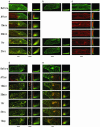Frequent fusion and fission of plant mitochondria with unequal nucleoid distribution
- PMID: 15136720
- PMCID: PMC419687
- DOI: 10.1073/pnas.0401077101
Frequent fusion and fission of plant mitochondria with unequal nucleoid distribution
Abstract
The balance between mitochondrial fusion and fission influences the reticular shape of mitochondria in yeasts. Little is known about whether mitochondria fusion occurs in plants. Plant mitochondria are usually more numerous and more grain-shaped than animal mitochondria. BLAST searches of the nuclear and mitochondrial genome sequences of Arabidopsis thaliana did not find any obvious homologue of mitochondrial fusion genes found in animals and yeasts. To determine whether mitochondrial fusion actually occurs in plants, we labeled mitochondria in onion epidermal cells with a mitochondria-targeted, photoconvertible fluorescent protein Kaede and then altered the fluorescence of some of the mitochondria within a cell from green to red. Frequent and transient fusion of red and green mitochondria was demonstrated by the appearance of yellow mitochondria that subsequently redivided. We also show that mitochondrial fission occasionally occurs without an equal distribution of the nucleoid (DNA-protein complex in mitochondria), resulting in the coexistence of mitochondria containing various amounts of DNA within a single cell. The heterogeneity of DNA contents in mitochondria may be overcome by the frequent and transient fusion of mitochondria.
Figures




References
Publication types
MeSH terms
Substances
LinkOut - more resources
Full Text Sources
Other Literature Sources
Research Materials

